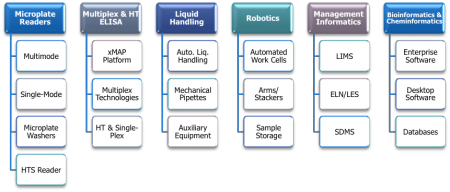December 4, 2018 -- Lab automation refers to a collection of technologies that are involved in making faster and more efficient repetitive laboratory tasks. Lab automation generally consists of six categories: liquid handling; microplate readers; LIMS (Laboratory Information Management System), ELN/LES (Electronic Laboratory Notebook/Laboratory Execution System) and SDMS (Scientific Data Management System); multiplex and high-throughput ELISA systems; informatics; and robotics. Each of these techniques aims to increase the speed, efficiency, and accuracy of lab work, and enhance overall productivity.

The laboratory automation market is extremely fragmented, as most companies primarily focus on one or two technology segments rather than broadly participate in this market. In 2016, the laboratory automation market captured around 8% of the total analytical and life science instrumentation market, and we estimate it will grow 3.3% this year, mainly fueled by a healthy and growing pharmaceutical and biotechnology sector. The top six companies in the lab automation space account for 40% of the global market. Tecan, with a share of 9%, is the market leader. However, it is closely followed by Thermo Fisher Scientific and PerkinElmer. The next three major firms are Eppendorf, BIOVIA (formerly known as Accelrys until acquired by Dassault Systèmes) and Luminex, with slightly smaller shares.
Copyright © 2018 scienceboard.net


